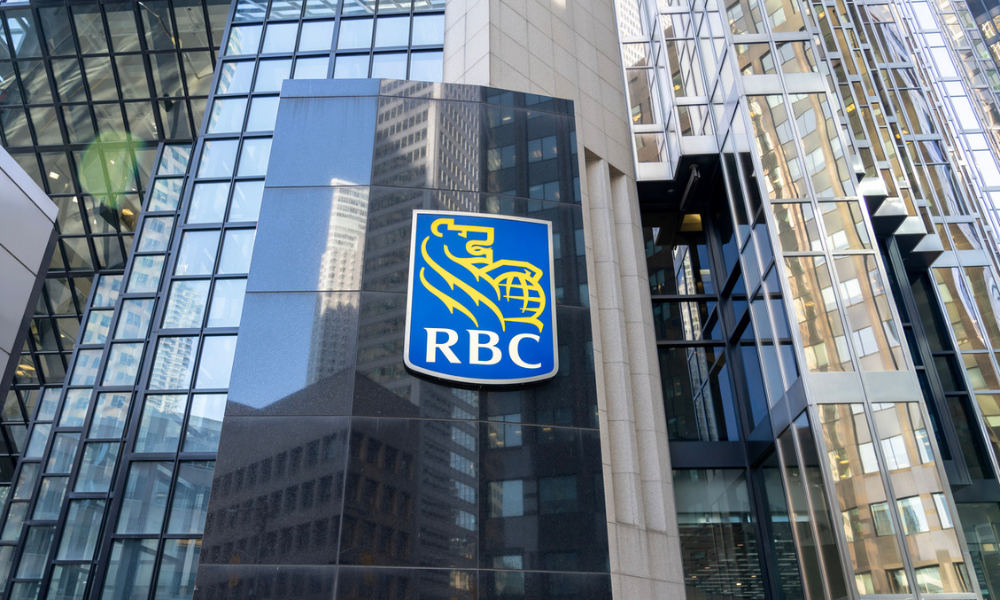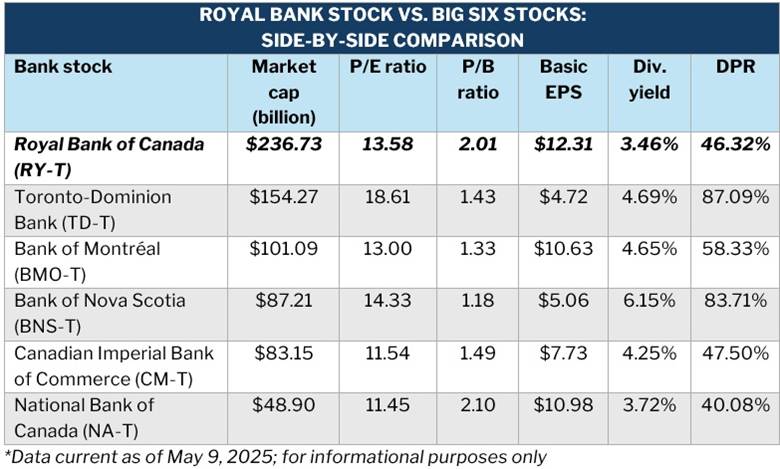Royal Bank stocks are on a roll after experiencing lows from the last fiscal year. Is it a good idea to buy now or should you wait? Read on and find out

Updated June 2, 2025
Royal Bank of Canada (RBC) stands atop of its peers as the country’s biggest bank. It also ranks among the largest in the world – and the biggest on the Toronto Stock Exchange (TSX) – in terms of market capitalization. And with its recent acquisition of another major industry player in HSBC, Royal Bank has risen heads and shoulders above its Big Six cohort.
More than a year after the deal was finalized, investors are asking, how did the purchase of Canada’s seventh-largest bank impact Royal Bank stocks? Have RBC stocks become overvalued? Wealth Professional answers these questions and more in this guide.
How are Royal Bank stocks performing?
To get a clear picture of how Royal Bank stocks are performing, we’ll need to first look at its most recent earnings report.
In its 2025 first quarter financials, the banking giant revealed that net income reached $5.1 billion, a 43 percent jump from the same period last year. The acquisition of HSBC Canada has added $214 million to RBC’s net income for the quarter.
During the period, Royal Bank’s diluted earnings per share (EPS) also increased to $3.54, a 42 percent rise year-on-year. The spike was driven by growth across each of the bank’s business segments.
The results also showed an increase in total provisions for credit losses (PCL) of $237 million compared to a year ago. The amount was intended to cover the losses in the personal and commercial banking, and wealth management segments.
While these losses were tough to swallow, Royal Bank did benefit from lower taxes and growth in some of its loan and capital market units. The bank also stated that these provisions represented a steady rise from pandemic lows.
The banking giant, however, saw pre-provision pretax earnings hit $7.5 billion, a 45 percent spike year-on-year. The firm attributed the rise to higher net interest income brought about by the inclusion of HSBC’s numbers.
Royal Bank also reported higher capital markets revenue, resulting from higher gross sales in its global markets and corporate and investment banking segments. The bank was also able to return $2.4 billion in capital to shareholders through common share dividends and share buybacks.
If you’re new to investing and wondering how stock investments work, this beginners’ guide on how to buy stocks can prove handy.
Royal Bank stocks key metrics
There are several key indicators of a good bank stock. For this article, we will look at the metrics below to see how well Royal Banks stocks are performing:
- market capitalization
- price-to-earnings (P/E) ratio
- price-to-book (P/B) value ratio
- earnings per share
- dividend yield
- dividend payout ratio (DPR)
Note, however, that market figures tend to vary each day. Here are the RBC stock values for these metrics. These are based on data from the charting platform TradingView and the financial research platform YCharts. The figures are accurate as of May 9, 2025.
- Royal Bank stocks market cap: $236.73 billion
- Royal Bank stocks P/E ratio: 13.58
- Royal Bank stocks P/B value ratio: 2.16
- Royal Bank stocks basic EPS: $12.31
- Royal Bank stocks dividend yield: 3.46%
- Royal Bank stocks dividend payout ratio: 46.32%
Royal Bank’s stock price hovers between $138.22 and $180.45 over the 52-week period. On May 9, the price opened at $167.99, the highest that day, and closed at $167.59. This was a 0.45 percent rise from the previous day. The latest stock price is also a 21.2 percent rise from its 52-week low.
If you’re also interested in RBC’s mutual fund offerings, this guide on Royal Bank mutual funds can give you options.
How do Royal Bank stocks compare with other banking stocks?
To give you an overview of how RBC stocks compare with those of other major Canadian banks, WP has compiled figures from TradingView, TMX Money, and Morningstar.
Here’s a side-by-side comparison of the stocks of the Big Six banks based on the latest key indicators mentioned above.

Meanwhile, here’s a side-by-side comparison of the share price of Royal Bank stocks vs. the country’s largest banks as of May 9, 2025.

The numbers above are for informational purposes only. They shouldn’t be used for trading. If you need guidance on stock investing, it’s best to consult an experienced financial advisor like the ones featured in our Best in Wealth Special Reports.
For new investors trying to make sense of these stock investment buzzwords, here’s a brief explanation of each term:
|
Term |
Definition |
Calculation |
|
Market cap |
Total value of a firm’s shares of stock; gives investors a picture of a company’s size compared to its competitors |
Total number of outstanding shares multiplied by share price |
|
P/E ratio |
Indicates whether a stock’s price is high or low based on a company’s earnings |
Current share price divided by earnings per share |
|
P/B ratio |
Ratio of current market cap to a company’s accounting value |
Stock price per share divided by book value per share |
|
Earnings per share |
Shows how much profit a company makes for each share of stock |
Net income minus preferred dividends; difference divided by number of outstanding shares |
|
Dividend payout ratio |
Indicates how much a company pays out to investors in dividends in comparison to the earnings of the stock |
Annual dividend per share divided by earnings per share |
|
Dividend yield |
Shows how much a company pays in dividends yearly, relative to its stock price |
Annual dividend per share divided by price per share |
You can check out our detailed analysis of the other Big Six stocks in our other guides:
Is Royal Bank stock a good buy?
Royal Bank stocks are hovering firmly in positive territory, surging more than 53 percent since hitting lows during the October 2023 rout. RBC stocks are clearly on a roll, but this isn’t the only reason why they’re worth investing in. Here are the top reasons why Royal Bank stocks are a good buy:
1. Industry leader
As Canada’s largest financial institution, Royal Bank stands out above the rest of its competitors. It offers an extensive range of products and services apart from banking solutions. These include capital markets, insurance, investment, and wealth management.
RBC is also growing faster than its Big Six cohort, beating earnings estimates set by analysts in the past several quarters. In addition, the banking giant’s balance sheet remains strong and capable of taking in further loan losses.
RBC has a rich history spanning 160 years. It also boasts a global reach, with operations in more than two dozen countries outside Canada and the US. Given its prestigious history and established reputation as a sound financial institution, Royal Bank can be deemed as a good investment.
2. HSBC mega-deal
Another reason is Royal Bank’s acquisition of HSBC’s Canadian unit. All HSBC offices in the country are now open as RBC branches and with this comes more than 780,000 HSBC clients across the nation.
The merger, which is one of the largest in Canada’s banking history, has also pushed RBC share price even higher. This has allowed the financial giant to pay juicier dividends.
While the deal didn’t come cheap – costing $13.5 billion – it makes Royal Bank much stronger than its industry rivals.
3. Strong earnings
Royal Bank’s adjusted net income for the 2024 fiscal year reached $17.4 billion, 10 percent higher than its 2023 results. The rise was driven by strong performance across all business segments. Adjusted return on equity (ROE), meanwhile, remained the same as RBC continued to be profitable.
The banking heavyweight finished the fiscal year with a slight dip in common equity tier one (CET1) ratio. Despite that, the 13.2 percent it registered still exceeded the 11.5 percent requirement set by regulators. This also translates into billions of dollars in excess cash, giving Royal Bank plenty of extra funding to ride out market volatility. A good portion of this cushion, however, has been set aside for the HSBC mega-deal.
4. Dividend yield
Royal Bank increasing its dividend twice in 2024 is a signal to investors that its board expects a rosy profit outlook for the 2025 fiscal year. The bank announced a quarterly dividend of $1.48 per share to end the year after already increasing the dividend to $1.42 in May that year. This pushed up the annualized payout to $5.92 per share, offering a dividend yield of around 3.3 percent at the current share price.
And with a DPR of around 40 percent, Royal Bank maintains a healthy balance of providing dividends for shareholders and retaining earnings for future investment opportunities.
Is Royal Bank stock undervalued?
Royal Bank stocks are considered undervalued, with most analysts giving the stock a “Strong Buy” rating. Analysts have set an average price target of about $184, with the highest price target reaching $198. Both figures are at least 10 percent higher than the current market price.
This makes the banking giant a great investment option. RBC stocks are potentially undervalued, given the firm’s strong financial performance and growth prospects.
Check out this guide for a list of the best-performing Canadian bank stocks to invest in right now, complete with analysis.
How to buy Royal Bank stocks
Buying RBC stocks is a straightforward process that can take as little as 15 minutes. All you need is some industry knowledge, sufficient funds, and a brokerage account. Here’s a step-by-step walkthrough of how to buy Royal Bank stocks:
Step 1: Choose a brokerage platform
Royal Bank has its own brokerage platform, RBC Direct Investing, where you can access a range of investment opportunities. The platform, however, doesn’t always suit all types of investors.
If you’re looking for an option with lower transaction fees or more advanced trading features, it may be better to look at standalone brokerages. The key is searching for a reputable company that will allow you to deposit funds from an RBC bank account.
Step 2: Open a brokerage account
Once you have chosen a brokerage platform that matches your needs, you’ll need to register and create an account. The process varies depending on the platform but generally, it’s quite simple. You’ll be asked to provide personal information, including your:
- name
- address
- phone number
- Social Insurance Number (SIN)
- basic employment and financial information
Step 3: Transfer funds to your account
Once the account has been approved, you can transfer funds from your RBC account with just a few clicks. Most platforms offer different funding options, including electronic and wire transfers. Some also allow check deposits.
Step 4: Research, analyze, and select stocks
Since you’re investing in Royal Bank stocks, all you need to do is search the platform for the RY stock code.
When purchasing any stocks, it’s important to conduct thorough research and select only the stocks you want to invest in. Most brokerage platforms also provide research and data analytics tools to help you make an informed decision.
It also helps to pay attention to external factors such as the company’s performance and growth potential, and industry trends. You can likewise make a list of stocks you’re interested in, so you can track their performance.
Step 5: Buy Royal Bank stocks
Choose the type of order you’d want to buy RBC stocks for. Here's the banking giant's latest share information to help with your decision.
You can purchase RBC stocks using two methods:
- Market order where you buy Royal Bank stocks at the current market price, but this also means that you don’t have control over the price.
- Limit order, which allows you to set a specific price to purchase RBC stocks for. The transaction, however, won’t push through if you can’t buy the stocks for the price you set or better pricing. A limit order can be valid for up to three months, although some brokerages allow it to sit longer.
Step 6: Monitor your investments
Once you’ve purchased the stocks, monitor their performance regularly. Brokerage platforms provide tools that enable you to track the performance of your investments, so you can adjust as needed.
If you’re an investor looking for the best value for your money, Royal Bank stocks can be a smart investment for a range of reasons. The bank’s stellar first quarter performance shows growth across all its business segments. It also boasts strong capital and a diversified business model, which make it primed for growth. Add to these RBC’s focus on digital innovation and expansion of its wealth management services that can further boost its earnings in the future.
Get more information about Royal Bank stocks in our Investment News Section. Bookmark this page for easy access to breaking news, expert insights, and the latest industry developments.



